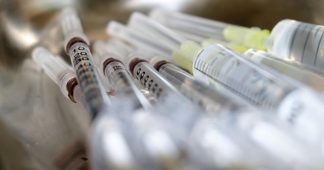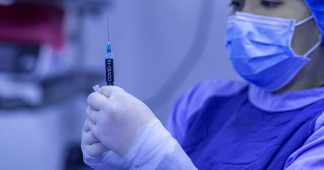A new report finds that pharmaceutical monopolies are preventing the production of significant quantities of vaccines in Africa, Asia and Latin America.
By Sarah Lazare
A new report finds that, despite months of claims to the contrary by Big Pharma, at least 120 manufacturers in Africa, Asia and Latin America currently have the capacity to produce mRNA vaccines, but are not doing so because drug companies Pfizer and Moderna are refusing to share technology and information (and governments are not compelling them to). As a result, millions of people across the globe stand to die due to lack of access to vaccines, all because our international system is predicated on pharmaceutical monopolies, not cooperation and knowledge sharing.
The long list of facilities is the finding of a brief by two healthcare researchers: Achal Prabhala, coordinator of the AccessIBSA project, and Alain Alsalhani, from Médecins Sans Frontières. In a new paper, they identified 120 global manufacturers “with the technical requirements and quality standards to make mRNA vaccines” — production that would almost certainly dramatically increase the global availability of Covid-19 vaccines and thereby save millions of lives.
For context, 73 percent of all vaccines that have been administered have gone to wealthy and middle-income countries, while less than 1 percent went to the poorest ones. The World Health Organization (WHO) warned on Tuesday that the entire continent of Africa may not attain a 70 percent vaccination level until 2024, all while wealthy nations, including the United States, are moving forward with booster shots for vaccinated individuals. The equitable distribution of mRNA vaccines, in particular, has the potential to reverse this trend.
Why mRNA vaccines? According to the researchers, “Unlike older (pre-2020) vaccine technologies which are cell-based, mRNA vaccines are made through biochemical rather than biological processes. This makes for a simpler system of production, and one that is more predictable and easier to transfer to other manufacturers than previous vaccine technologies.” This means, quite simply, that it takes less time to scale up production. “It takes three to seven days to produce a batch of the active pharmaceutical ingredient for the Pfizer-BioNtech vaccine,” the researchers explain, “as compared to one month for an equivalent batch of the AstraZeneca vaccine.”
This technology is also the simplest to adapt to new variants, like Omicron, which the WHO has identified as extremely high risk. As Human Rights Watch puts it, “The WHO-listed Covid-19 mRNA vaccines showed great efficacy in clinical trials, and are understood to be among the easiest to modify to target new variants such as Omicron.”
Any delay means more lives lost, and the ability to scale up manufacturing rapidly in the Global South could be a game changer for a pandemic that appears nowhere near ending. So, what is the best method for globally distributing mRNA vaccines as quickly as possible? The answer certainly isn’t relying solely on rich countries to make donations, given their dismally poor follow-through in delivering on such pledges. The researchers posit a fairly obvious solution: allow the Global South to unleash its own vaccine manufacturing capacity.
As Paige Oamek and I reported in November, the pharmaceutical industry has long argued that the Global South does not have the ability to rapidly produce mRNA vaccines. “There is no idle mRNA manufacturing capacity in the world. This is a new technology, you cannot go hire people who know how to make mRNA — those people don’t exist,” Stéphane Bancel, chief executive of Moderna, said in May.
This line of argument has been used to undermine the case for the temporary suspension of patent rules at the World Trade Organization, a proposal first introduced by India and South Africa in October 2020 (and aggressively opposed by the pharmaceutical industry.) Such a proposal is aimed at dramatically increasing the Global South’s ability to produce generic versions of vaccines, to quickly get them into as many arms as possible. But the pharmaceutical industry has been heavily invested in trying to convince the public and world leaders that suspending patent rules wouldn’t result in increased manufacturing of vaccines, so why bother?
We now know this pharmaceutical industry talking point is false. A New York Times investigation published in October identified 10 facilities in India, Brazil, Thailand, South Africa, Argentina and Indonesia that are good candidates for manufacturing mRNA vaccines. Now, the Prabhala and Alsalhani paper, which identifies 120 such facilities,suggests that global vaccine manufacturing capacity is likely far, far higher. This news is not groundbreaking: In September, Indian civil society organizations identified 34 manufacturers in 20 countries likely capable of making the Johnson & Johnson vaccine. But the finding adds urgency to calls for immediately sharing vaccine technology and information with the Global South. It shows our collective capacity to manufacture and distribute mRNA vaccines may be magnitudes greater than our current one, if only we engage in the simple act of cooperation.
First, a note on how the researchers came up with this list: In their paper, they explain that they identified companies that “manufactured sterile injectables and had been certified by a reputable agency or organization for good manufacturing practices.” Eight-two percent of the companies on their list were found by consulting the European Medicines Agency’s EudraGMDP database “where we found companies who had passed inspection of their facilities for export of a sterile pharmaceutical product to the European Union.” They also looked at approvals from the WHO and U.S. Food and Drug Administration along similar lines, as well as a small number of subsidiaries of Western companies. The researchers reached out to some of these companies in Asia and South Africa and were told that, yes, those companies believe they could quickly develop mRNA vaccine manufacturing capability.
This list was convincing enough to inspire the confidence of Human Rights Watch and Médecins Sans Frontières, which wrote a joint letter calling on the United States to “transfer technology for Covid-19 vaccines.” The organizations write, “The U.S. government should urgently identify capable manufacturers from these and other lists and ensure that they, along with relevant WHO technology transfer hubs, have timely access to intellectual property, vaccine technology, and materials needed to support manufacturing.” Human Rights Watch and the European Center for Constitutional and Human Rights also wrote a letter to the German government issuing similar demands. (Germany and the United States both funded the development of mRNA vaccines.)
While the Biden administration has claimed since May to support a patent waiver at the WTO — a mechanism that would allow countries to produce cheaper, generic versions of vaccines — my previous reporting reveals that Biden is not fighting for this measure, and is failing to support the proposal from India and South Africa as it currently stands. This is despite the fact that his administration doubled down on this pledge as recently as November 29, as the Omicron variant stoked fear around the world.
In the absence of such a waiver, pharmaceutical companies — loyal, by definition, only to their shareholders — are deciding who lives and who dies. Meanwhile, the unencumbered spread of the disease is giving birth to new, dangerous variants of the virus, including Omicron, something Global South countries have warned would happen. As Luke Savage recently wrote for the Washington Post, “This state of affairs benefits no one, aside from a handful of drug companies.”
In the face of a deadly pandemic, we still don’t know what humanity is capable of: how many vaccines we could produce and distribute, or the extent to which we could improve upon the vaccines already in circulation. The greatest possible vaccine doesn’t even exist yet, because Pfizer and Moderna executives are not putting their heads together to figure out how to combine the best attributes of both, in terms of storage, manufacturing ease, or even effectiveness. Our fates have never been more bound together, yet those working on vaccine technology are divided into small silos. And the life-saving vaccines they’re developing — and the knowledge needed to produce them — are being hoarded by wealthy countries, as the global death toll ratchets up.
As Prabhala and Alsalhani write, “We need to be making billions more doses in order to vaccinate the world. The most effective way to do so would be by diversifying and expanding the manufacture
*Sarah Lazare is web editor and reporter for In These Times. She tweets at @sarahlazare.
Published at inthesetimes.com
We remind our readers that publication of articles on our site does not mean that we agree with what is written. Our policy is to publish anything which we consider of interest, so as to assist our readers in forming their opinions. Sometimes we even publish articles with which we totally disagree, since we believe it is important for our readers to be informed on as wide a spectrum of views as possible.










